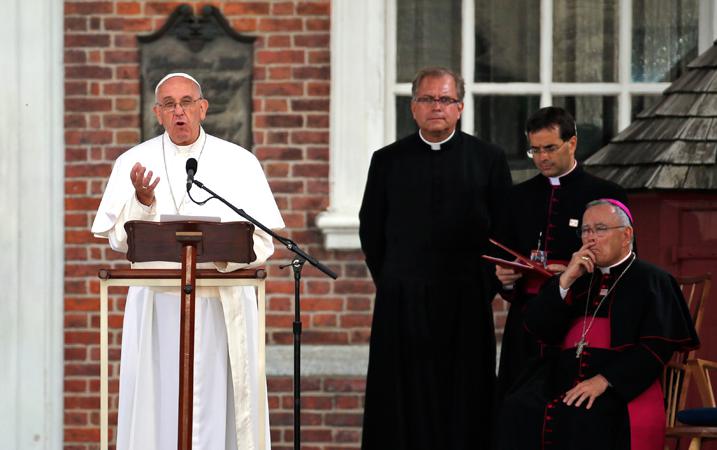|
What it means that Pope Francis met Kim Davis
By John L. Allen Jr.
ROME – If anyone suspected that Pope Francis didn’t really mean the strong words he spoke on religious freedom last week in the United States – that he was phoning it in, while his real concerns were elsewhere – claims that he held a private meeting with Kentucky county clerk Kim Davis certainly should lay that suspicion to rest. The meeting was first reported by Robert Moynihan of Inside the Vatican magazine. A Vatican spokesman said Wednesday, “I do not deny that the meeting took place, but I have no comments to add,” which, in effect, is a way of allowing the report to stand. Taken together with his unscheduled stop to see the Little Sisters of the Poor, the Davis encounter means Francis has expressed personal support to leading symbols of the two most contentious fronts in America’s religious freedom debates – the contraception mandates imposed by the Obama administration, and conscientious objection on gay marriage. Before unpacking what it means, let’s roll out the necessary caveats. First of all, the fact that someone arranged a brief encounter between Francis and Davis does not necessarily mean that Francis initiated the contact, or even that he necessarily grasps all the dimensions of her case. By her own account it was an extremely brief greeting, just long enough for the pope to tell Davis to “stay strong” and to give her a rosary. Asking for prayers and offering a blessed rosary to individuals following a meeting is a customary gesture for Pope Francis. It would be over-interpreting things to read the meeting as a blanket endorsement of everything Davis has said or done. In addition, we don’t yet know how Francis sees the balance between honoring one’s conscience and upholding one’s responsibilities as a public official, because he hasn’t addressed that question at any length.The fact that the Vatican has chosen not to comment probably means, at least in part, that they don’t want to be dragged into a detailed discussion of Davis’ situation.That said, there’s no way to view the encounter other than as a broad gesture of support by the pope for conscientious objection from gay marriage laws, especially taken in tandem with his statement aboard the papal plane that following one’s conscience in such a situation is a “human right” – one, he insisted, that also belongs to government officials. So what does it mean? First, it means that Francis has significantly strengthened the hand of the US bishops and other voices in American debates defending religious freedom. In the wake of a massively successful trip in which Francis was lauded for his stands on issues ranging from climate change to immigration to fighting poverty, it will be more difficult for anyone to wrap themselves in the papal mantle without at least acknowledging his concerns vis-à-vis religious freedom. Second, Francis may also have smoothed the waters in advance for round two of the Synod of Bishops on the family, which opens on Sunday. Last time around, the question of how welcoming the Church ought to be to gays and lesbians was a major flashpoint, in part because conservatives worried it might lessen the Church’s resolve to resist a “redefinition” of marriage. By holding the Davis meeting, Francis has probably reassured conservatives that he’s not priming the pump for going soft on same-sex marriage. Ironically, the Davis meeting may actually increase the odds of the synod recommending a more pastoral approach to same-sex relationships, since there won’t be the same fear about where such an opening might lead. Third, Francis has also debunked impressions of a rift with the American bishops when it comes to the “wars of culture.” Yes, Francis called the bishops to spurn “harsh and divisive” rhetoric and to embrace dialogue as a method. That does not imply, however, that he believes the substance of their concerns is mistaken, and by meeting both the Little Sisters of the Poor and Davis he drove that point home. Fourth and finally, the Davis meeting confirms that the US trip amounted to the public debut of “Francis 2.0,” meaning a pope more clearly perceived as standing in continuity with Catholic teaching and tradition, as well as in solidarity both with previous popes and with the bishops. To put the point in crudely political terms, Francis is a figure who utterly defies the usual left/right divides, equally capable of meeting Kim Davis and embracing poor immigrant children at a Harlem school – seeing both as part of a continuum of concern for human dignity. That will be a source of consolation to some and consternation to others, but in any event it’s now officially part of the Francis narrative. Contact: john.allen@cruxnow.com
|
.
Any original material on these pages is copyright © BishopAccountability.org 2004. Reproduce freely with attribution.
